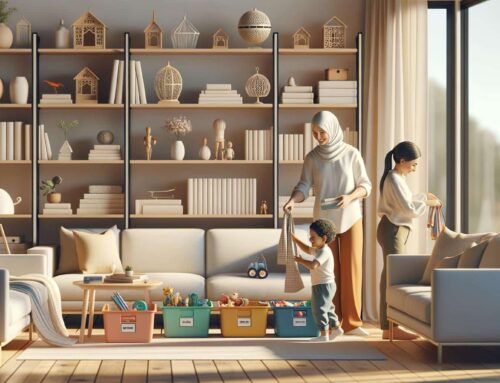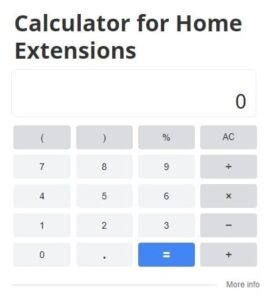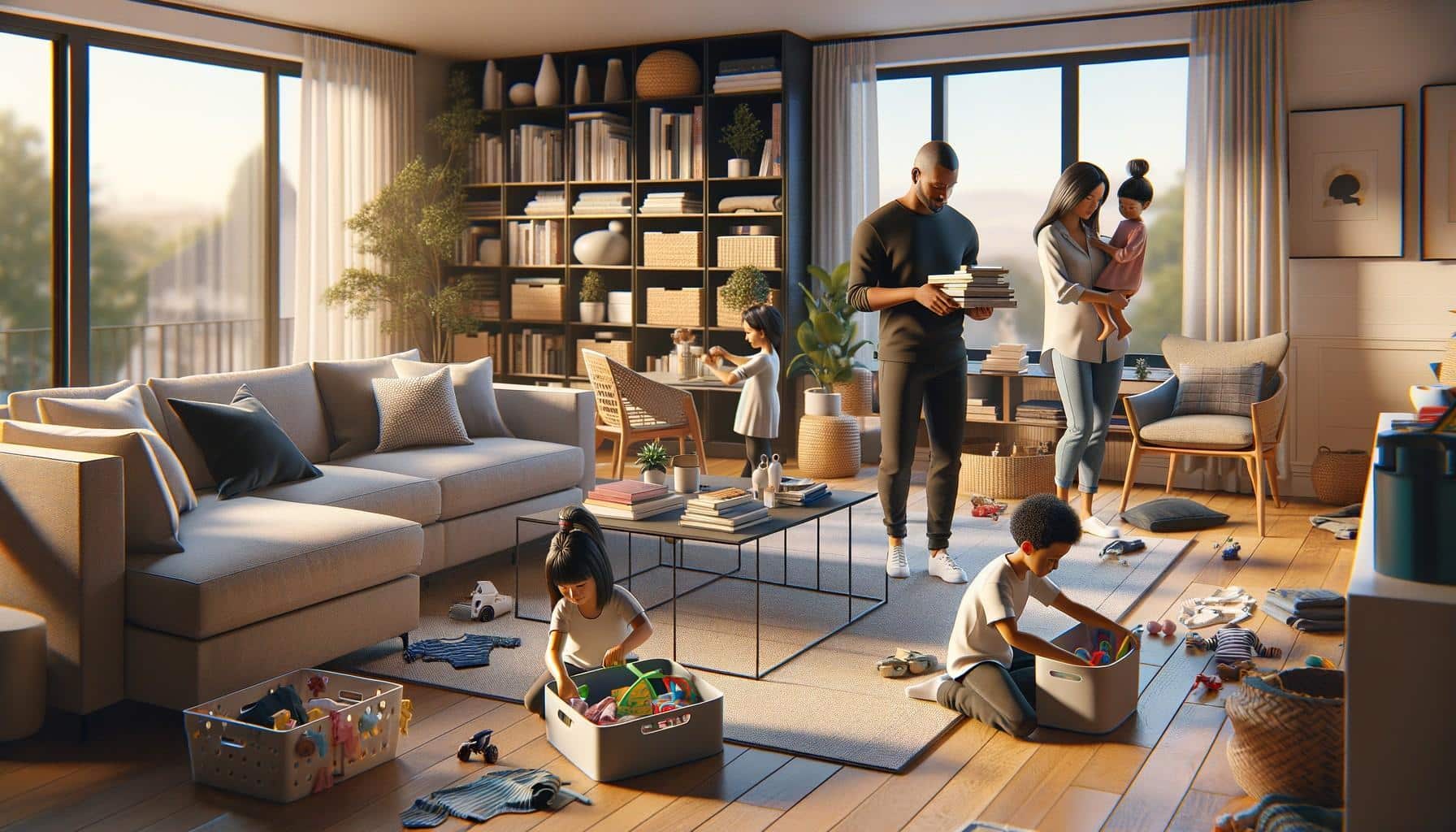
Clutter accumulates faster than most homeowners realise, with the average American home containing over 300,000 items according to UCLA research. We at Home Owners Association see families struggling daily with overwhelming spaces that drain energy and productivity.
The right tips for decluttering your home can transform chaotic rooms into organised, functional spaces within weeks. Strategic room-by-room approaches combined with proven sorting methods create lasting results that stick.
Which Rooms Should You Declutter First
Start with your living room and kitchen to create immediate momentum because these spaces generate the most visual impact. The living room alone contains numerous items that accumulate over time, which makes it the perfect test ground for your skills. We recommend you dedicate your first weekend to these high-traffic areas because family members notice changes instantly, which boosts motivation for harder tasks ahead.
Transform Your Main Living Spaces First
Clear coffee tables, entertainment centres, and kitchen counters within the first 48 hours of your project. Research from Princeton Neuroscience Institute shows that visual clutter competes for attention and decreases focus by up to 32 per cent. Attack kitchen appliances that haven’t moved in six months, expired pantry items, and duplicate utensils that take up drawer space.
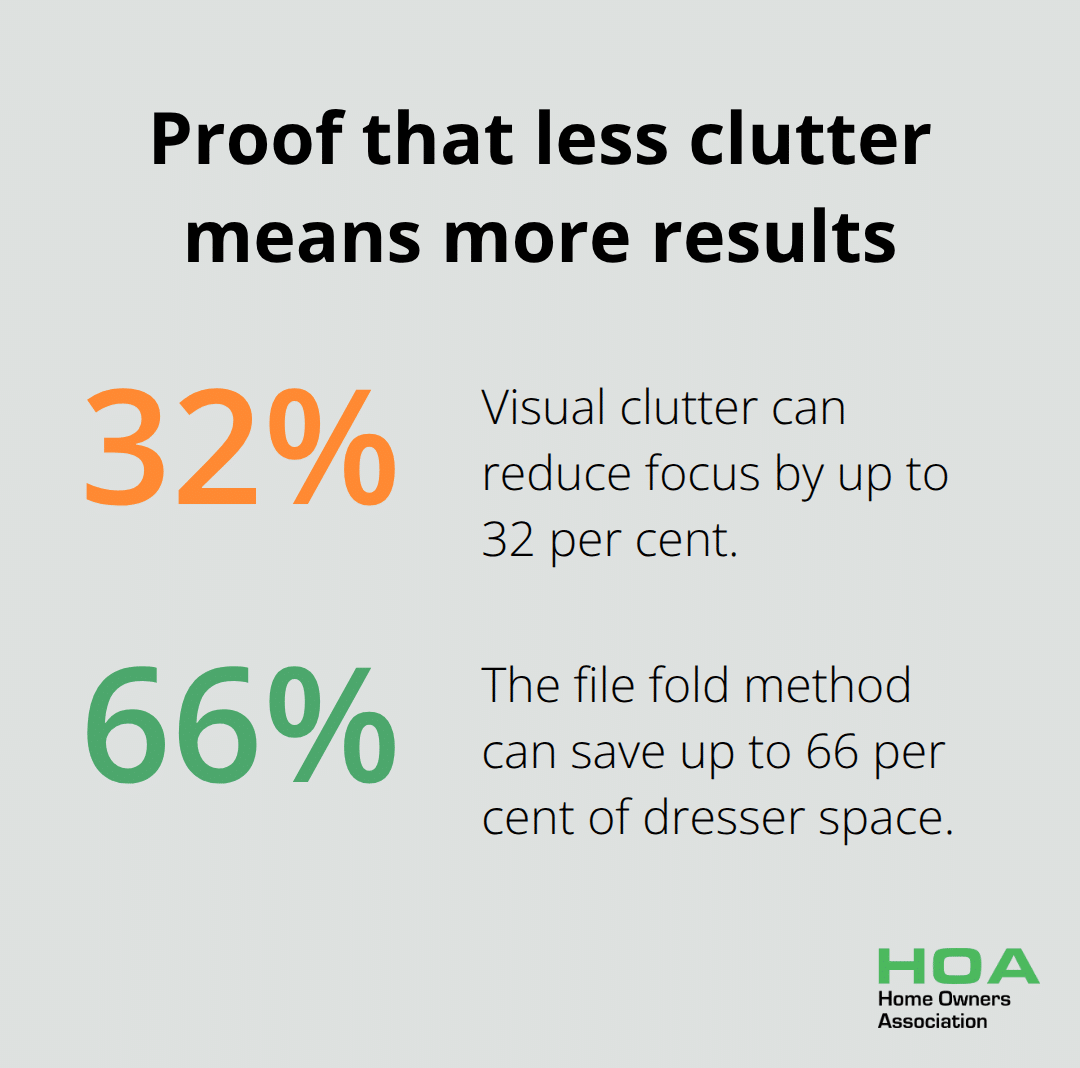
Living rooms benefit from the 10-item rule: remove 10 visible objects daily until surfaces feel spacious and functional again.
Bedrooms and Storage Areas Come Second
Bedrooms require different tactics because they store both daily essentials and forgotten items from years past. Start with clothes and use the file fold method, which saves up to 66 per cent of dresser space compared to traditional methods. Closets need the hanger test: reverse all hangers and only turn them forward after you wear items. After six months, donate anything still turned backward. Storage areas like linen closets work best with the category method rather than shelf-by-shelf clearing (this allows your brain to process similar items together more efficiently).
Save Garages and Basements for Last
These spaces intimidate most homeowners because they contain the heaviest items and deepest emotional attachments. Garages average 7,000 items per household, which makes them overwhelming start points that often lead to abandoned projects. Weather-resistant items can wait while you build confidence in climate-controlled areas. Basements store holiday decorations, childhood memories, and broken appliances that require more complex decisions than daily-use items upstairs.
Once you establish which rooms to tackle first, you need proven methods to sort through items efficiently and make quick decisions about what stays and what goes.
What Methods Work Best for Sorting Items
The four-box method transforms overwhelming piles into manageable decisions within minutes of starting any room. Label four containers as Keep, Donate, Sell, and Trash, then touch each item only once before placing it in the appropriate box. This system prevents the common mistake of creating maybe piles that stall progress for weeks. Research shows people make better evaluative judgements when options are limited to clear categories rather than open-ended choices.
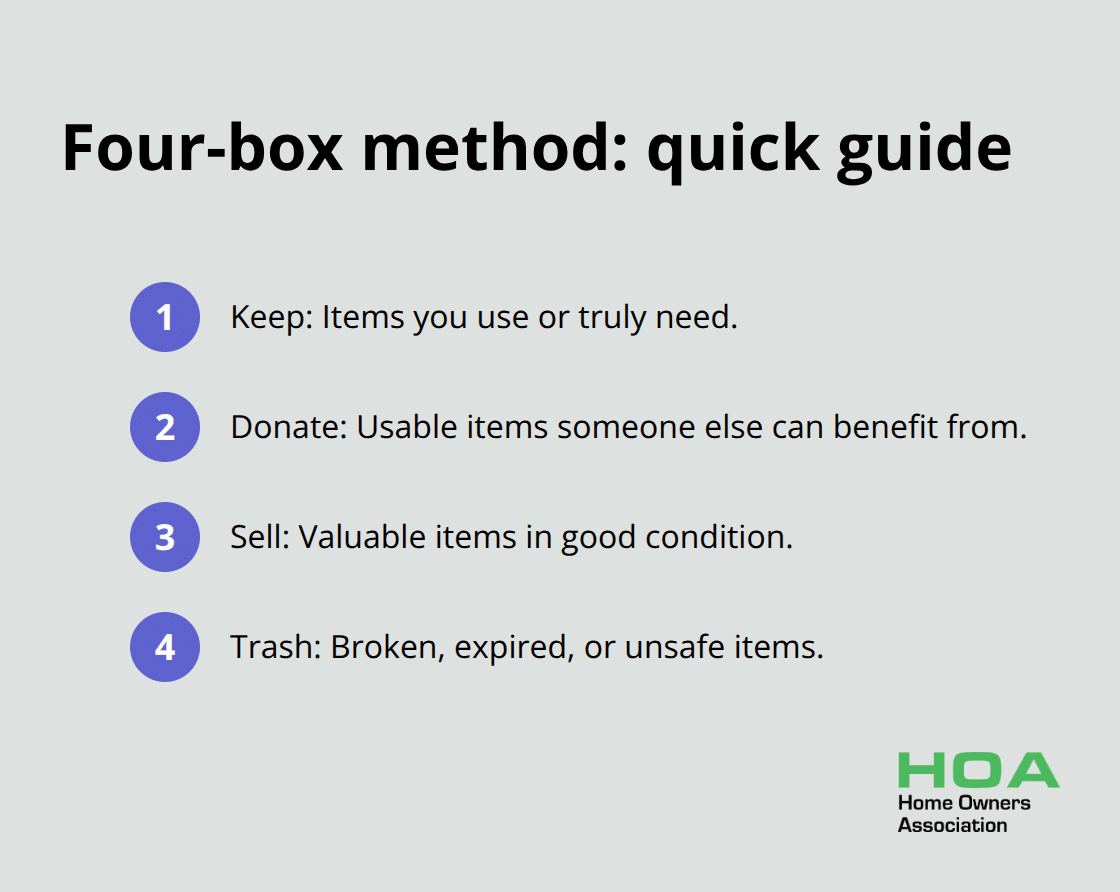
Apply the One-Year Test to Everything
Items unused for twelve months should leave your home immediately because storage costs exceed replacement value for most household goods. Housing costs continue to rise with the median home price reaching $423,200 in the fourth quarter of 2023. Clothing, kitchen gadgets, and books represent the biggest culprits in this category. Sports equipment that collected dust through two seasons, exercise machines that serve as expensive coat racks, and duplicate items hidden in storage all fail the one-year test. We recommend you photograph questionable items before you donate them because visual records satisfy emotional attachment without physical storage burden.
Speed Up Decisions With Clear Categories
The keep pile should contain only items used within six months and items with genuine future plans attached to specific dates. Donation boxes work best for items worth under $50 that someone else can use immediately. You should sell electronics, furniture, or collectibles valued above $100 because lower-value items cost more time than money earned (this threshold helps you focus on profitable sales). Trash includes anything broken beyond reasonable repair, expired products, and items with safety concerns. Set a timer for 15 minutes per room section to prevent overthinking decisions that become harder with extended consideration.
Master the $20/20 Rule for Quick Choices
Items you can replace for $20 or less within 20 minutes should leave your home without hesitation. This rule eliminates the mental burden of storing just-in-case items that rarely prove necessary. Kitchen gadgets, basic tools, and common household supplies fall into this category most often. The fear of regret rarely materialises because replacement costs stay minimal for everyday items (studies show people regret fewer than 5 per cent of discarded possessions).
These proven methods create the foundation for effective decluttering, but success depends on your ability to maintain these systems once you establish them throughout your home.
How Do You Keep Your Home Clutter-Free Forever
Success requires specific daily habits that prevent clutter from returning after your initial effort. Spend exactly 10 minutes each evening and put items back in their designated places because homes with consistent evening routines maintain organisation longer than those without structured systems. Morning coffee preparation becomes your daily clutter check: clear kitchen counters completely before you start your day and address any items that accumulated overnight. Weekly maintenance takes 45 minutes maximum when you tackle one room each day rather than attempt whole-house sessions that often get postponed.
Design Storage That Actually Works
Every single item needs a specific home address where it always returns after use. The average household contains numerous categories of items but limited designated storage locations according to organisation research from UCLA. Create zones based on frequency of use: daily items within arm’s reach, weekly items in nearby cabinets, and seasonal items in remote storage areas. Transparent containers work better than opaque ones because visibility increases usage and prevents duplicate purchases. Label everything with specific categories rather than generic terms like miscellaneous because precise labels reduce decision fatigue when you put items away.
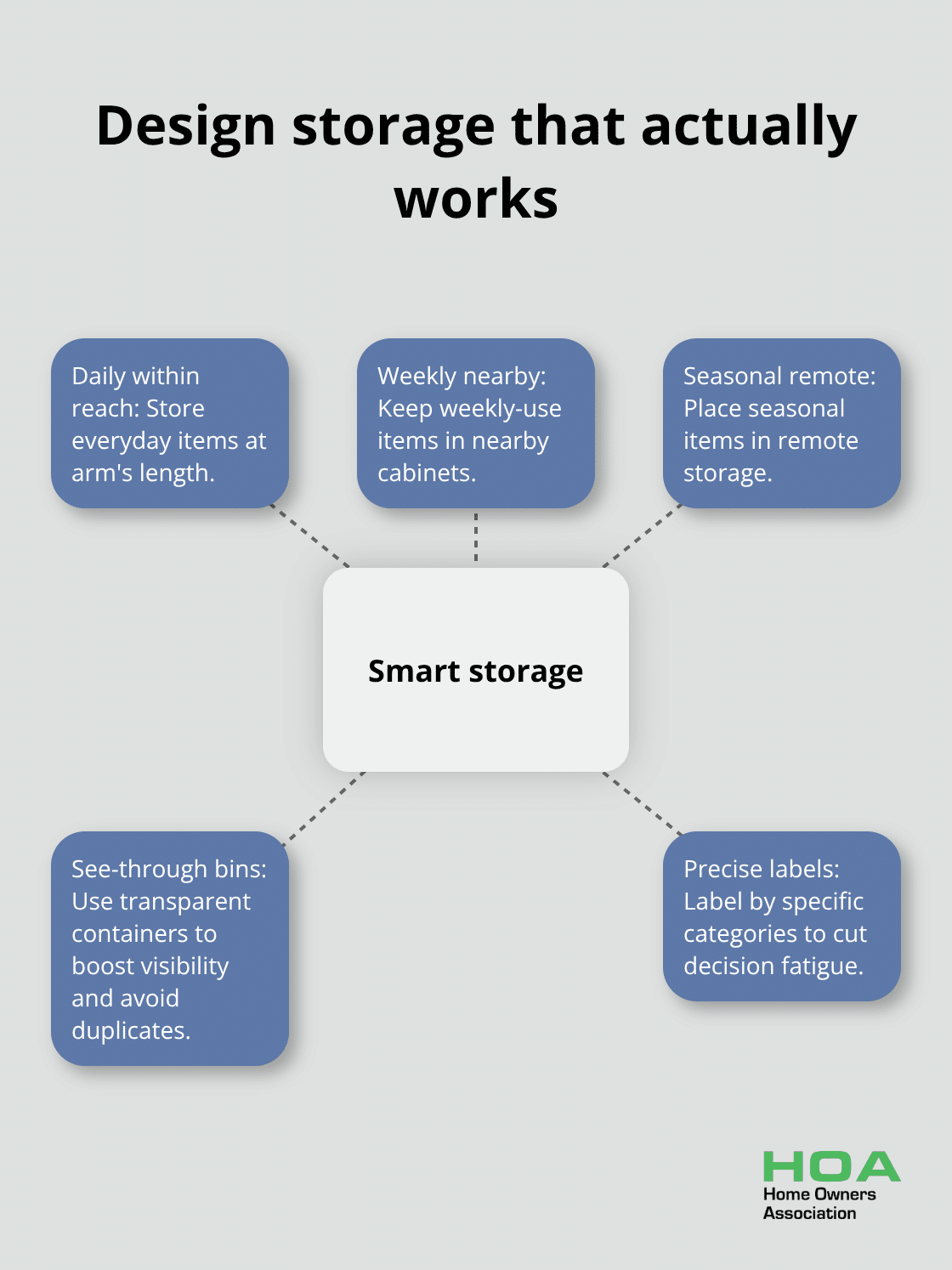
Stop New Clutter Before It Starts
The one-in-one-out rule prevents accumulation and requires you to remove one item whenever something new enters your home. Consumer habits show significant acquisition patterns that exceed disposal rates. Apply this rule immediately at your front door rather than hope to remember later because delayed decisions lead to clutter buildup within days. Gift occasions require advance plans: designate specific items for removal before holidays and birthdays arrive. Digital purchases count too because subscriptions, apps, and online memberships create mental clutter that affects physical habits (this includes streaming services and software downloads).
Build Maintenance Routines That Stick
Daily surface clearing takes three minutes per room and prevents the visual chaos that leads to complete system breakdown. Set phone alarms for 8 PM each night to trigger your 10-minute reset routine across all main areas. Weekly deep maintenance follows a simple schedule: Monday for kitchen drawers, Tuesday for bathroom cabinets, Wednesday for bedroom closets. This approach prevents weekend marathon sessions that feel overwhelming and often get skipped entirely (research shows people complete more tasks when they break them into daily segments).
Final Thoughts
These tips for decluttering your home create lasting transformation when you follow the room-by-room strategy and proven methods. Start with high-impact areas like living rooms and kitchens to build momentum that carries through bedrooms and storage spaces. The four-box method combined with the one-year rule eliminates decision paralysis that stops most homeowners from progress.
Clear spaces reduce stress levels and save 2.5 days annually that people spend searching for lost items. Families report better focus, improved sleep quality, and healthier habits when clutter disappears from their homes. Clean surfaces create calm environments that support productivity and reduce housework time significantly (Princeton research confirms these benefits).
Take action tonight and clear one surface completely in just 10 minutes. Tomorrow tackle another small area with the same focussed approach. We at Home Owners Association support Melbourne homeowners with expert guidance for all home improvement projects.


